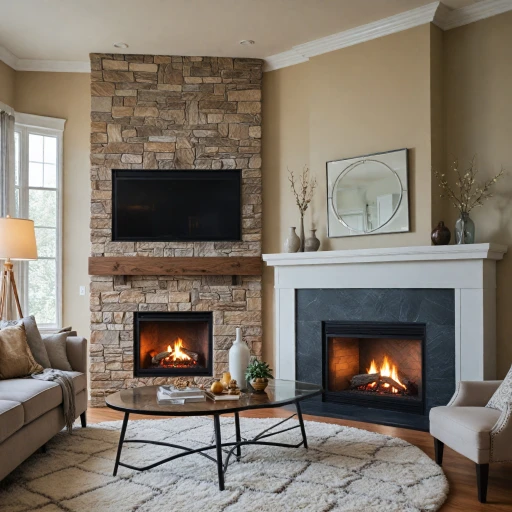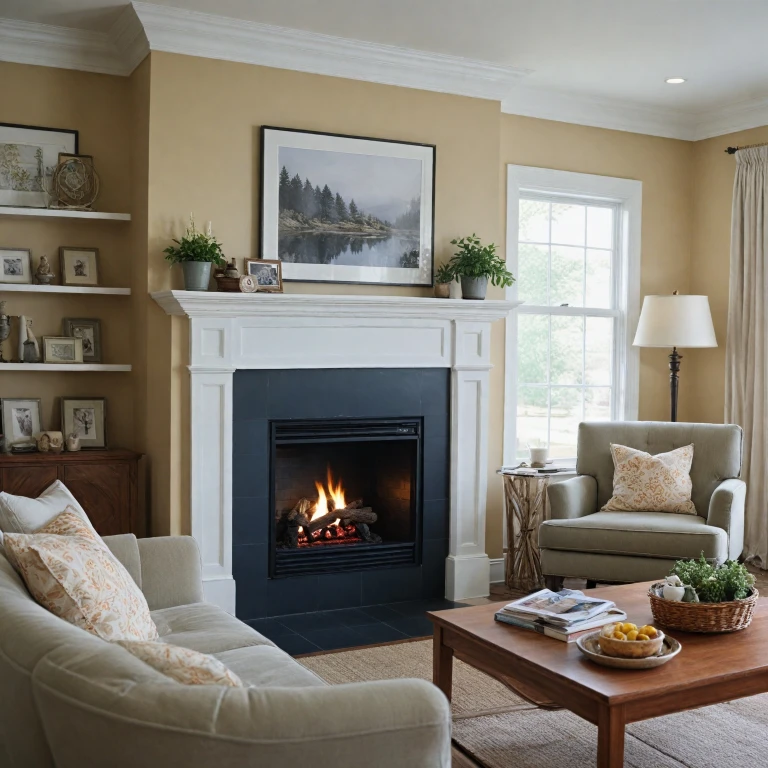Understanding How Electric Fireplaces Work
How Electric Fireplaces Generate Heat
Electric fireplaces, far from being mere decorative pieces, use modern technology to provide efficient heating. Unlike traditional wood-burning or gas fireplaces that require actual flames to produce warmth, electric fireplaces utilize heating elements. These elements, often in the form of strips, convert electrical energy into heat. If you're curious about their detailed functioning, you might want to explore more on the
role of heating strips in electric fireplaces.
Electric fireplaces often feature motors that produce a realistic flame effect. While these flames don't provide heat, they enhance the ambiance of the room, mimicking a traditional fireplace's cozy look.
Heat Distribution Mechanism
After the heat is generated, it's dispersed throughout the space, commonly through a built-in fan in the electric fireplace unit. The fan forces the warm air into the room, ensuring even heat distribution. Many modern models come with adjustable heat settings and sometimes even a remote control, allowing users to regulate the temperature of their room effortlessly.
Comparing to Traditional Heating Sources
When thinking about switching to an electric fireplace, it's crucial to weigh them against traditional heating methods like wood-burning or gas fireplaces. Electric models might not deliver the high heat output that gas fireplaces provide, but they're generally easier to maintain. Additionally, electric fireplaces are typically safer for indoor use, as they don't generate actual flames or harmful emissions like carbon monoxide.
Considering these points can help you understand that electric fireplaces offer a unique blend of convenience and efficiency, making them a viable heating option for many households.
Comparing Electric Fireplaces to Traditional Heating Methods
Electric Vs. Traditional Heating: Comparing Methods
When it comes to warming up your room, electric fireplaces bring some unique attributes that stand out from their traditional counterparts like gas or wood-burning fireplaces.
Firstly, electric fireplaces function differently than wood-burning or gas fireplaces. They don't actually burn anything; instead, they use electrical components to produce heat, which is then distributed throughout the space using a fan or infrared technology. This process eliminates the need for chimneys or vents, making them a more versatile option for installation in a variety of indoor locations.
In contrast, gas fireplaces rely on burning natural gas or propane to generate heat, while traditional wood-burning models require logs, adding a certain ambiance with real flames but also requiring regular cleaning, ventilation, and a steady supply of wood. This can limit their convenience and increase the cost of continual use.
Let's not forget about safety. Electric fireplaces offer a safer heat source as there's no real flame involved, meaning no direct exposure to fire or smoke, reducing the risk associated with traditional burning fireplaces. This makes them appealing for spaces where safety is a primary concern, like homes with kids or pets.
Moreover, electric units often come with adjustable heat settings and options for different flame effects, allowing you to customize the ambiance of the room without excessively impacting your energy bill. Some even include remote controls for ultimate convenience, making it easy to adjust the fireplace's operation from the comfort of your couch.
Electric fireplaces can be wall-mounted, standalone, or even designed to fit as an insert in an existing mantel, providing flexibility that traditional options can’t match. That's not all; they also typically require less maintenance and are known for their longevity when compared to more traditional methods. Curious about how dimensions play into finding the right fit for your space? Check out a guide
here.
So, while traditional fireplaces have their charm, electric fireplaces embody modern convenience, combining safety and efficiency that can be tailored to various needs and preferences.
Benefits of Using Electric Fireplaces
Discover the Advantages Electric Fireplaces Bring
Electric fireplaces have become popular for a host of good reasons. They are not just a modern alternative to traditional heating methods but offer several advantages worth considering when planning how to heat your space.
- Simplicity and Ease of Use: Let's face it, electric fireplaces are incredibly user-friendly. No need to chop wood or clean up ashes. With just a simple switch or even a remote control, you can ignite those flames and enjoy the cozy warmth.
- Cost-Effectiveness: On the long haul, electric fireplaces can be cheaper to run compared to a traditional wood or gas fireplace. Since you can control the heat output and flame settings, you're not burning through resources in the same way.
- Safety First: With electric fireplaces, safety is a top priority. No risk of sparks flying, as with traditional wood burning models, and they remain cool to the touch, which is ideal for homes with kids or pets.
- Flexible Placement Options: Whether you desire a centerpiece for a room or a subtle heater tucked into a wall, electric fireplaces offer versatile options like wall mounted units or fireplace inserts. You can find the best fit for any room, whether square feet challenged or not.
- Aesthetics Without Compromise: Electric fireplaces often come with realistic flame effects that can rival those of traditional wood and gas fireplaces. Whether you're looking to match a fireplace mantel or want something sleek and modern, there's a model for your aesthetic.
Embracing an electric fireplace not only adds warmth to your space but also elevates your interior's charm, while often improving the heat efficiency over traditional burning fireplaces. Make informed choices to enjoy every flicker of the flame.
Limitations and Considerations
Things to Keep in Mind When Considering Electric Fireplaces
While electric fireplaces bring a ton of benefits to the table, it's not all roses. Here are some factors you might want to chew over before making your decision.
- Heat Output Limitations: Electric fireplaces typically max out around 5,000 BTUs, which is great for smaller areas but can be a bit lacking if you're trying to heat a larger room or open space. This means if you have a sizeable living room or an extensive open-concept design, you may need more than one unit or a different heating source.
- Dependence on Electricity: Unlike their gas and wood counterparts, electric fireplaces rely solely on electricity. This means a power outage could leave you without heat. So, if you're in an area prone to blackouts, that’s something to factor into your decision.
- Absence of a Real Flame: The beauty of a traditional wood-burning fireplace or even a gas fireplace lies in its real flames. While electric fireplaces do simulate flames quite convincingly, they may not completely satisfy those longing for that authentic crackling and glowing experience.
- Installation Considerations: You have a variety of electric fireplace models—freestanding, wall mounted, and fireplace inserts—but installing them may require some planning. Some units might need professional installation, especially if you're considering wall mounting, whereas others like mantel units are simple plug-in options.
- Outdoor Use: Electric fireplaces are designed primarily for indoor use. If you're looking for something to warm up your patio or backyard, a gas fireplace or space heater might be the best alternative.
Still interested in going electric? Once you sort out these considerations, the next step is finding an electric fireplace that suits your space perfectly in terms of style, budget, and of course, the kind of heat output you need.
Choosing the Right Electric Fireplace for Your Space
Picking the Ideal Electric Fireplace for Every Nook and Cranny
Choosing the right electric fireplace to heat up your life can feel a bit like playing matchmaker for your home. Consider these key factors to ensure you find the perfect fit:
- Room Size: How much square feet are we talking? Electric fireplaces are an outstanding option, but selecting a unit that aligns with the room's dimensions is crucial for effective heating. A smaller fireplace insert may struggle in a vast living room, while a more modest bedroom could efficiently toast up with a compact wall mounted unit.
- Heat Output: Different models come with varied heat settings, so you want to pick one that matches your needs. If you're aiming to warm the whole space, check the heater's wattage. Tailor your choice based on whether it's a cozy den or an expansive open-floor layout.
- Style and Placement: Whether you're falling for the traditional mantel with a wood finishing vibe or eyeing a sleek, modern design, electric fireplaces come in various styles. Consider models that can be integrated into a mantel, or those that stand as centerpiece wall decor with flame effects to die for.
- Functionality and Controls: Want to kick back and adjust the flames or temperature without leaving your couch? Opt for fireplaces electric models that offer remote control for maximum ease. Check reviews and perhaps seek something with variable flame settings for ambiance at your fingertips.
- Safety Features: Electric fireplace safety is a top priority. Ensure the model you land on has safety attributes like automatic shut-off to prevent overheating. This is especially crucial in homes with kids or pets.
- Cost and Efficiency: While these fireplaces might save you from a hefty gas bill, be strategic. Balance your budget with essential features. While some fireplace electric units may demand a bit more upfront, the cost-saving nature in terms of heating efficiency often offset the initial investment.
In the labyrinth of models, finding the best match may seem like a tall order. But considering these points will guide you toward a decision that maximizes comfort and efficiency in your space. Electric fireplaces stand as a smart and chic replacement to their traditional wood burning counterparts or gas fireplaces, presenting both flair and function without the mess or maintenance. Keep these points in mind as you set out on your search.
Maximizing Efficiency and Heat Output
Tips to Boost the Warmth From Your Electric Fireplace
Bringing the comforts and warmth of an electric fireplace into your home is just the beginning. While these fireplaces offer numerous benefits over traditional gas and wood-burning units, maximizing their heat output is key for making the most of them. Here’s how you can ensure they warm your room efficiently:
- Placement Matters: Ensure the electric fireplace is positioned away from drafty windows and doors. A central wall in your room can help distribute heat evenly. Wall-mounted models work wonders in smaller spaces, taking advantage of vertical space and freeing up floor room.
- Understand Heat Settings: Many electric fireplaces come with adjustable heat settings. Start with a lower setting that gradually increases as the room requires more warmth. Make use of the remote control options for easy adjustments from the comfort of your couch.
- Keep It Clean: Regularly clean the fan and vents on your unit to prevent dust buildup, which can reduce the efficiency. A clean heater ensures better airflow and optimal flame performance.
- Insulate Your Space: Enhance the heating experience by ensuring your room is well insulated. Sealing gaps, using thick curtains, or adding a fireplace mantel can help trap the heat within your living space.
- Right Models for the Right Space: Choose electric fireplaces suited to the size of your room. Look for units that specify the square feet they can effectively heat to avoid disappointment. Larger rooms may require bigger units or multiple fireplaces electric for efficient heating.
- Combining with Other Heating: In particularly cold climates, electric fireplaces can be combined with traditional heating methods for an extra boost. This hybrid approach can significantly increase overall comfort and maintain cozy temperatures.
- Leverage Supplemental Heating: Use your unit as a supplemental heating source, allowing you to lower the thermostat for the rest of the house. This strategy not only boosts warmth in specific areas but can also lead to energy savings.
Remember, while electric fireplaces are effective, being mindful of safety measures is essential. Keep flammable materials away and ensure proper usage according to manufacturer guidelines. By following these tips, your space will be warm and inviting, embracing you in comfort as you enjoy the cozy artificial flames dancing in your new fireplace.

